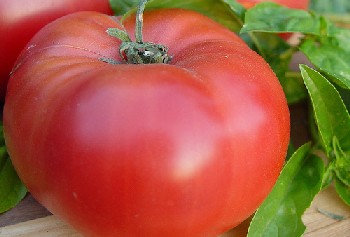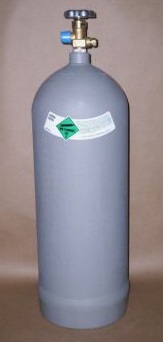Tip: This ezine is a visual experience. Set your email to html instead of text only to enjoy our
great graphics and photos. Gmail users: click on the Display Images Below link.
April, 2009: Heirloom Vegetables *Aphids *Supercharge with CO2

Working in the garden… gives me a profound feeling of inner peace.
~Ruth Stout
Hydroponics in the News
Heirloom Vegetables
The brandywine tomato (pictured above) is the most famous of the heirloom tomatoes.
Just what are heirloom vegetables? They are plants grown from seeds that have been propagated over the decades; preserved and passed down from one family or group of people to the next generation. Hence the name heirloom. Heirloom veggies have recently become very trendy and popular by home gardeners as they experiment with their edible heritage (A taste of the past).
Sadly, many prized species of vegetables have been lost forever, as fewer people saved seed from year to year. Just like an extinct animal, they can never be resurrected. So growing heirlooms and saving the seeds through the years is a very noble and worthwhile project.
Why else should you grow heirloom vegetables? These home-bred species usually have superior taste and tenderness. In planting these strains, you help contribute to the effort of saving special cultivars from generations past.
Besides the Brandywine, other heirloom tomatoes which are well suited to hydroponic gardens: Cherokee Purple, Rainbow, Giant Beefsteak, Arkansas Traveler and Mortgage Lifter (?) Check around at garden supply centers, as more and more heirloom seeds are popping up on the shelves. Or try johnnyseeds.com, or burpee.com.
And make sure to dry and save some seed from each crop. Pick a tomato that is fully ripe, scrape the seeds and pulp from the inside. Wash and rinse with water to remove the fruit tissue, then place the seeds to dry on a paper towel for several days. Store in a tightly closed jar and keep refrigerated. Thoroughly dried tomato seeds can last up to 5 years when prepared and stored this way.
Pest of the Month

The Aphid
Aphids are probably the most common bad bugs you will find on your hydroponic plants. They seemingly appear by magic and multiply like rabbits! If you don’t nip them in the bud and obliterate the infestation, they will quickly take over your entire hydro crop!
Aphids, or plant lice, are small, soft-bodied insects which will attack ornamentals as well as vegetables. Most aphids are about 1/10 inch long, and though commonly green or black, they may be another color. Aphids feed in groups and love new, succulent shoots or young leaves. See photo below of a typical infestation.
Damage: Aphids feed by sucking up plant juices, while at the same time, they inject saliva into the host.
Light invasions are usually not harmful, but a major infestation can cause leaf curl, wilting, stunting of shoot growth, and delay in production of flowers and fruit, as well as a general decline in plant vigor. They can also transmit deadly plant viruses, which can kill your whole crop.

Recognition: Stunted plants with curled or deformed leaves. Aphids also leave a honeydew trail which attracts ants, another excellent clue that aphids are present.
How to prevent them: Plants should be examined closely daily to detect and kill the first invaders, before damage is evident.
How to kill them: If they have taken a foothold in your garden, you should first try biological warfare: get a jar and catch some ladybugs to turn loose on your plants. They have a voracious appetite for aphids and will quickly devour the entire invading army. Another natural predator is the lacewing. You can mail order live ladybugs or lacewings online.
If you see your entire hydro project going down the tubes, go on and spray with some of the safer insecticides: Pyrethrum (Garden Safe brand Insect Killer) and/or Safer Insecticidal Soap. You can find these at Walmart or garden centers.
Good luck and happy hunting!
New Techniques & Systems
CO2 In the Hydroponic Garden
Hey, want to supercharge your hydro garden?
You may remember as a child learning this basic truth about plant metabolism: humans take in oxygen and exhale CO2 (carbon dioxide); while plants do the opposite: they take in CO2 and release oxygen.
You can put this little bit of information to good use and energize your hydroponic grow unit! It is proven that adding supplemental CO2 to your crops not only speeds up growth, but promotes heavier yield (more fruit or bushier foliage); up to 40% more!
First, 2 cautions before you rush out to buy a tank of CO2:
1. I do not advise you to add this advanced method to your repertoire before you have some hydroponics experience under your belt. You need to have hands on practice first; tweaking and experimenting ’til you find the best system for you. If you add other variables too early, you will never be sure which factors are working and which are not. Keep it simple at first. There will be time later for experimentation once you have the nuts ‘n bolts of hydroponics screwed down tight.
2. Adding CO2 to your system really works best in a small room or enclosed growing space. The gas is fairly expensive, and to disperse it into a large room is really a waste of money and effort. But if you have a confined area, adding C02 supplementation can really provide impressive results. The initial cost investment is pretty high, but if you are serious about a high-yield garden, there is nothing that can improve your yield like CO2!
For the small hobby grower (that’s you) bottled CO2 is easy and safe to use.
How to do this?
All you have to do is buy a tank + emitter + tubing.
For 15 minutes every day, turn off your circulating fans and feed CO2 from a cylinder tank (like oxygen comes in) through airline tubing to the grow area. The plants suck it up and love it. That’s it!
Here’s what you will need: go on ebay for this equipment:
* 20# CO2 cylinder (tank)- (Be careful, not 20 oz paintball tanks), 20 POUNDS. Watch on ebay, you can find used tanks as low as $50 and new ones for $100.
* CO2 emitter (this is the yoke that goes on the tank and includes a regulator plus a flowmeter to dial in the flow). Search on ebay for CO2 emitter, or CO2 regulator. They cost $50-$100; AQUATEK is a good brand.
* Airline or oxygen tubing to bleed the CO2 into the growing area.
***WARNING: A corroded tank can explode on you, just like a bad oxygen cylinder or scuba tank can. If you do buy a used tank, have it tested by an expert, then get it filled with fresh gas. Where to get this done? Look in the yellow pages under welding, beer supplies or carbon dioxide.
 
We hope you have enjoyed this issue of The Urban Farmer Ezine. Each month, we will bring you another inspiring photo, gardening quote or idea, plus fresh new hydroponics news, techniques & products.
Insiders tips to get you growing…
~Stella and Simon from Hydroponics-Simplified.com
p.s. Worried about pollination? Learn all you need to know about the birds & bees of plants here:
Plant
Pollination Process
|


Reply